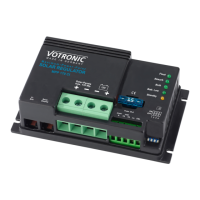- 11 -
Functions at the Main/Leisure Battery "12 V":
If solar power is missing (at night), the readiness for service of the controller will be indicated by short flashing of the LED
(light-emitting diode) "Batt. Low".
As soon as sufficient solar power is available, a lighting LED "Bulk" indicates proper control functions of the solar controller.
This always ensures the most favorable operating point for the interaction between solar panels, wiring and the battery.
1. Gentle pre-charge of deep discharged batteries up to 10 V (11 V for LiFePO4) (with max. 50% solar regulator power).
2. Maximum charging current (Bulk/I-Phase) in the lower and middle voltage range of the battery until the beginning of
the U1 phase (Absorb). MPP control active.
3. The solar controller monitors the charging time and charging current and then automatically switches to the following
U1 phase (Absorb).
4. During the following U1 phase (Absorb), the battery voltage is kept constant at a high level, the battery determines the
charging current itself based on its state of charge and the high battery capacity is charged, the "Bulk" and "Absorb"
LEDs light up. An already full battery is briefly held in the U1 phase, a (partially) discharged battery for full and cell
equalization charging (maintenance) correspondingly longer.
5. During the U2 phase (Float), the battery is kept at its charge level. Only the compensating recharging current
determined by the battery flows to keep it fully charged. This phase is not limited in time, the LEDs "Bulk", "Absorb"
and "Absorb" light up. In contrast to conventional controllers, the MPP control ensures lower panel loads and
temperatures, especially here. Additional consumers can be better supplied and the solar power is now almost
completely available to the consumers.
A switch back to the bulk phase or absorb phase takes place if the battery has been loaded for a longer period of time or if
the solar controller switches back to standby mode after sunset.
When using a temperature sensor for the lead-acid battery, the voltage values for temperature compensation
automatically shift slightly up for cold or down for warm.
For LiFePO4 batteries, this results in valuable battery protection, especially below 0°C.
Charging Process (Characteristic Line of Charging IU1oU2) at the Main/Leisure Battery "12 V":

